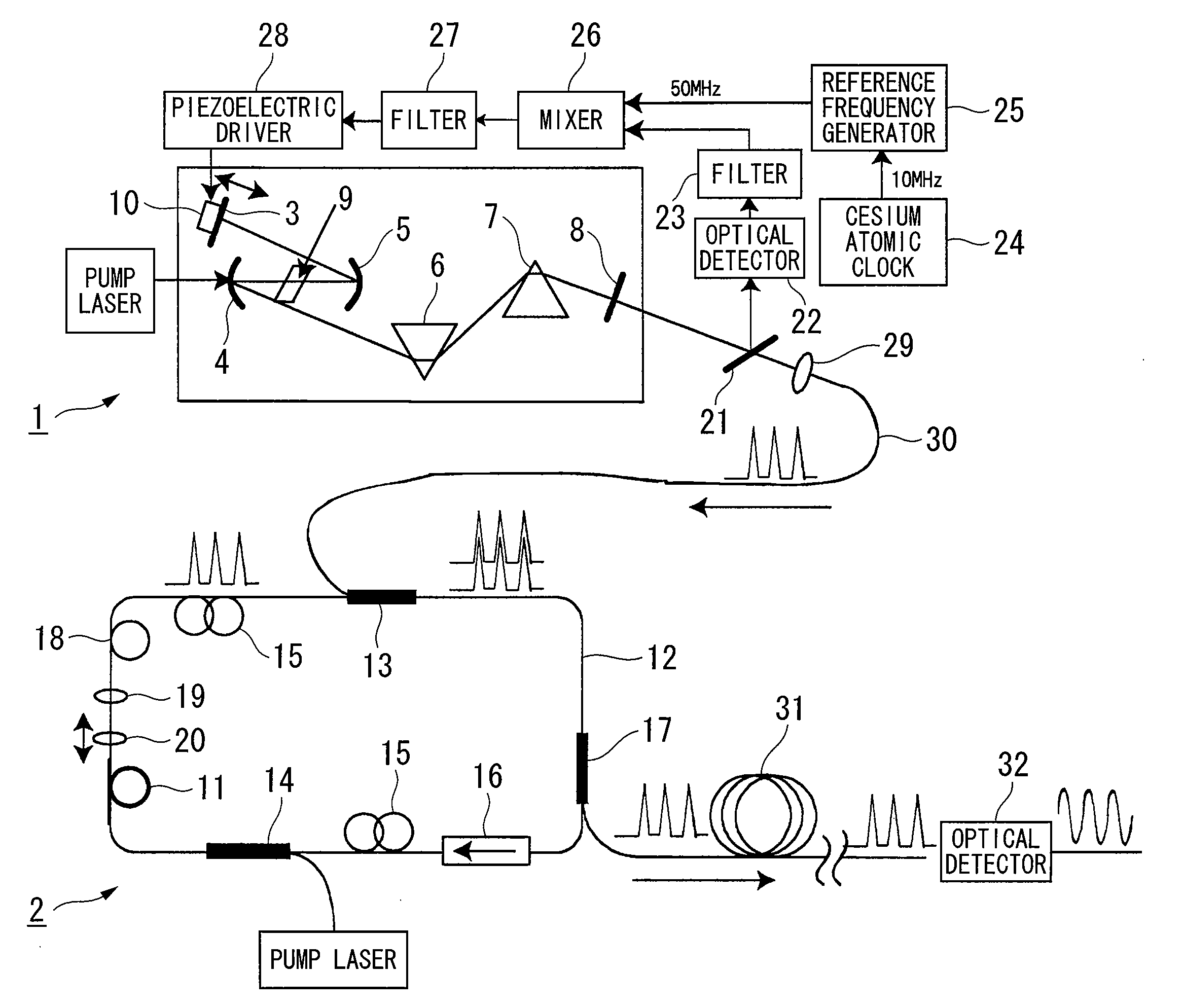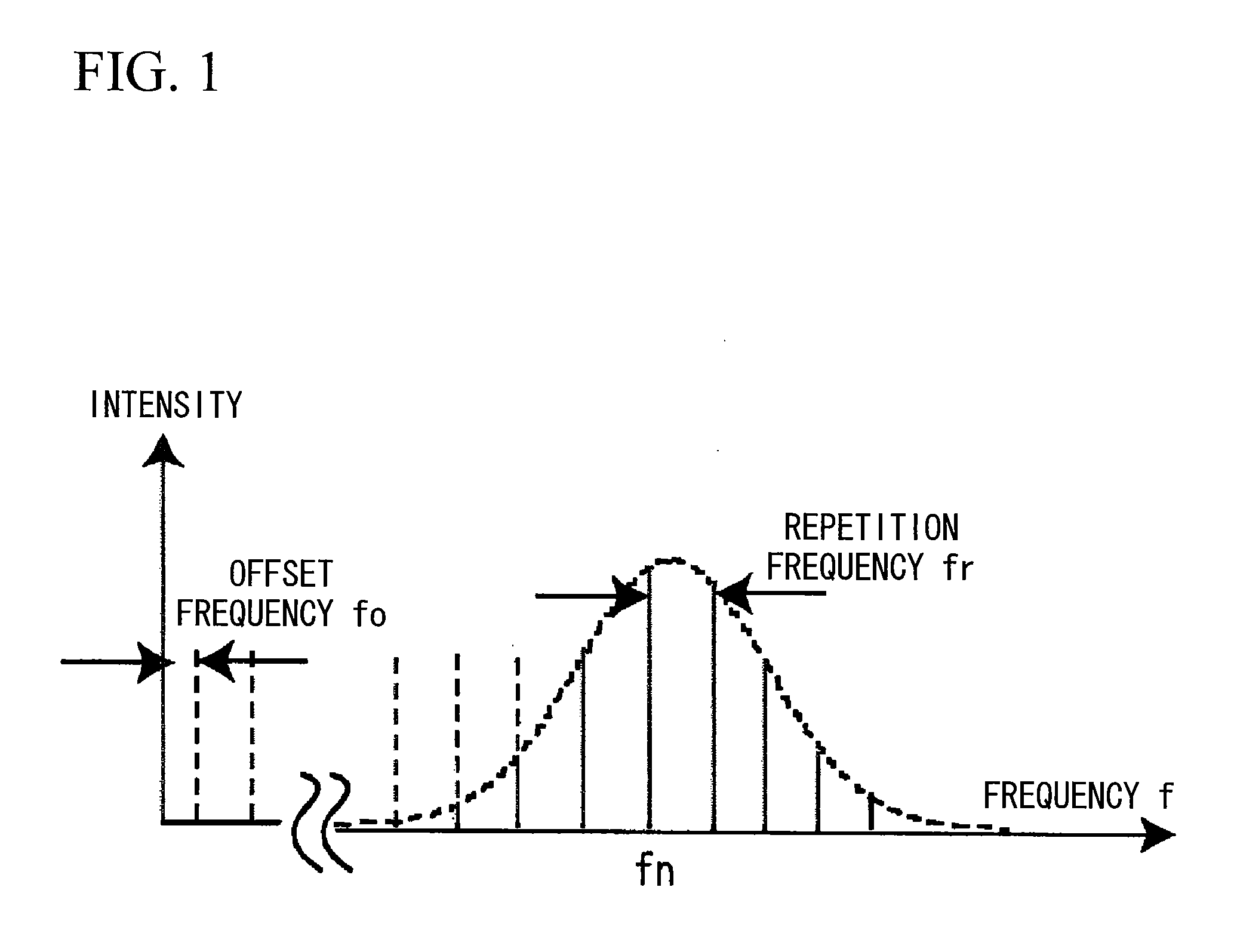Clock transfer device
a clock transfer and clock technology, applied in the direction of wave amplification devices, laser details, electrical equipment, etc., can solve the problems of difficult counting of existing electric circuitry, difficulty in transferring light, and existing electric circuitry to process ligh
- Summary
- Abstract
- Description
- Claims
- Application Information
AI Technical Summary
Benefits of technology
Problems solved by technology
Method used
Image
Examples
first embodiment
1. First Embodiment
[0049]Next, a clock transfer device according to a first embodiment of the present invention will be described with reference to FIG. 2 and FIGS. 3A to 3F.
[0050]In FIG. 2, a 1.3 μm wavelength chrome-forsterite laser 1 serves as the first mode-locked laser forming the reference clock, and a 1.5 μm wavelength erbium fiber laser 2 serves as the second mode-locked laser. The first mode-locked laser includes a resonator, which is constituted of a mirror 3, concave mirrors 4 and 5, prisms 6 and 7, and an output mirror 8, and a chrome-forsterite crystal 9 serving as a laser medium. One pair of the prisms 6 and 7 compensates for the dispersion of laser beams in the resonator and is used to generate a mode-locked pulse train (or a mode-synchronized pulse train). The mirror 3 is mounted on a moving stage (not shown) and is used to adjust a resonator length. Apiezoelectric element 10 is attached to the backside of the mirror 3 so as to realize fine adjustment of the resonato...
second embodiment
2. Second Embodiment
[0057]Next, a clock transfer device according to a second embodiment of the present invention will be described with reference to FIGS. 4 and 5, wherein parts identical to those shown in FIG. 2 are designated by the same reference numerals; hence, the detailed description thereof is omitted as necessary.
[0058]In FIG. 4, an 800 nm wavelength titanium-sapphire laser 33 serves as the first mode-locked laser, and the aforementioned 1.5 μm wavelength erbium fiber laser 2 serves as the second mode-locked laser. The constitution of the first mode-locked laser used in the second embodiment is substantially identical to the constitution of the chrome-forsterite laser 1 used in the first embodiment, whereas dispersion compensating mirrors 34 and 35 are used to perform dispersion compensation due to multiple reflection. Herein, the resonator length is appropriately determined so as to set the repetition frequency to 1 GHz.
[0059]The first optical pulse train output from the ...
third embodiment
3. Third Embodiment
[0069]Next, a clock transfer device according to a third embodiment will be described with reference to FIG. 6.
[0070]In FIG. 6, the repetition frequency of the first optical pulse train output from the first mode-locked laser is set to 40 MHz, and the repetition frequency of the second optical pulse train output from the second mode-locked laser is set to 60 MHz. Herein, every two optical pulses belonging to the first optical pulse train meet every three optical pulses belonging to the second optical pulse train at the same timing in the resonator of the second mode-locked laser. In addition, the triple of the repetition frequency (i.e., 40 MHz) of the first optical pulse train (where M=3) is synchronized with the double of the repetition frequency (i.e., 60 MHz) of the second optical pulse train (where N=2) at the same value, i.e., 120 MHz.
PUM
 Login to View More
Login to View More Abstract
Description
Claims
Application Information
 Login to View More
Login to View More - R&D
- Intellectual Property
- Life Sciences
- Materials
- Tech Scout
- Unparalleled Data Quality
- Higher Quality Content
- 60% Fewer Hallucinations
Browse by: Latest US Patents, China's latest patents, Technical Efficacy Thesaurus, Application Domain, Technology Topic, Popular Technical Reports.
© 2025 PatSnap. All rights reserved.Legal|Privacy policy|Modern Slavery Act Transparency Statement|Sitemap|About US| Contact US: help@patsnap.com



